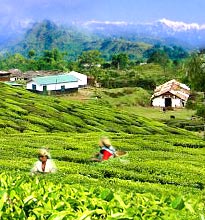Oja-Pali is a classical dance form of Assam, representing the rich tradition and cultural heritage of the state. Oja and Pali are actually the groups of chorus singers and dancers, with Oja as the leader and Palis as his assistants. A total of three or four Palis may be required for the dance and the principal one among them is called the Daina Pali. Apart from dancing, they also sing and play small cymbals, relating stories from the Epics and the Puranas. The songs sung by these people are basically in the Sanskrit language and of two types: malaci or malanci geets and jagar.
Many shades of the Indian classical dances, like hasta, gati, bhramari and asana, can be seen in Oja-Pali classical dance of Assam. There is a typical pattern of dressing for the Ojas as well. He has to wear a pag-jama or a ghuri, along with bangles, unti, ring and nupur and also has to tie a tangali. The Oja-Pali dance is again subdivided into three types - Vyasageet Oja, Suknarayani Oja and Ramayani Oja. Let us explore each one of them in detail.
Vyasageet Oja
This dance form is mainly a preaching of the Vaishnava culture of Assam. The themes for this dance have been adopted from the epic stories of Bhagavata, Mahabharata and Harivamsa and the attire for the chief is slightly different from that of the other Ojas. The leader here wears a long white skirt, a tight fitting jacket, a turban, anklets, and various gold ornaments in the neck, hands and ears.
Suknarayani Oja
The hymns for this form of dance were composed by an ancient Assamese poet, Sukabi Narayan Dev and are dedicated to the worship of the snake goddess, Manasa. The subject for this dance is the story of Behula and Lakhindar, which mainly deals with the tales of Goddess Manasa. In this case, the attire for the Oja consists of a long skirt (Chapkan), a white Dhoti, a pointed turban and various gold ornaments.
Ramayani Oja
The costume for this form of dance is similar to that of the Vyasa Oja and the songs sung here actually relate tales from the Ramayana.











